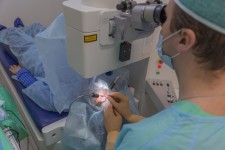
Ophthalmology Operation via shutterstock
According to the World Health Organization (WHO), cataracts are responsible for 51 percent of world blindness. For the 20 million people across the globe that that figure represents, the cause of their blindness is reversible.
Cataract surgery is not new but there are promising ideas behind some new treatment options.
Most recently, researchers from the University of California at San Francisco have identified a sterol molecule which in their trials was able to partially reverse cataracts in mice models and isolated human lenses. They found that the sterol molecules were able to lower the melting temperature of crystallins. When damaged or misfolded these crystallin proteins over time form cataracts. Initially they form soluble aggregates, but if left untreated for a prolonged period they are able to form stronger (covalent) bonds leading to an insoluble heat resistant compound. This compound is what causes the complaints of cloudy or opaque vision in persons with cataracts.
The hope is that the sterol molecules can be used to decrease the melting temperature of the crystallin, such that the protein can be stabilized while still in its soluble form, not yet mis-folded. Thereby halting progression of cataract formation.
Though this research is still in its early stages, the concept of treating cataracts with just an eye drop is groundbreaking. Not just for medicine, but also for the pockets of patients. Costs for cataract surgery in the US can range anywhere from $3,432 to $4,591 per eye, depending on how complicated the case and procedure are (along with a host of other factors). Possibly less depending on your insurance coverage. And of course, every surgical procedure, even the minor ones, come with their own risks.
Surgery is making strides also. Dr. Sanduk Ruit has instead been able to develop a simple cataract microsurgery procedure dubbed the Nepal method, at a cost of $25 per eye, or for free for those who are unable to afford it. His Nepal method, which he performs manually and without the use of sutures, has been validated and shown to have comparable outcomes to the Western medicine alternative utilizing machines. The study established that both procedures resulted in excellent surgical outcomes with low complication rates.
With global trends indicating an aging population with a longer life span, the incidence of cataracts is expected to rise, according to the WHO. However, as a leading cause of reversible blindness, with novel treatment options on the rise, it shouldn't. The key to combating this disease really lies in access to affordable health care, whether in the developed or developing world.


